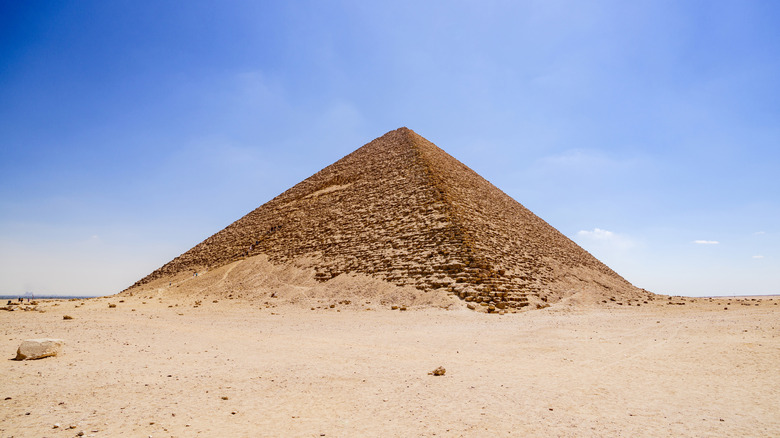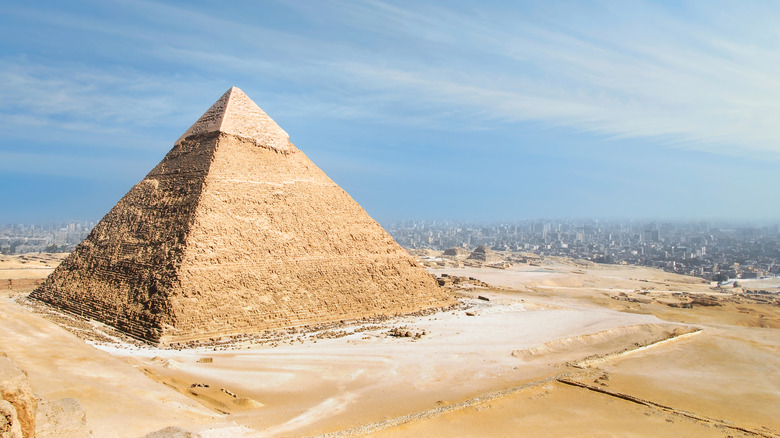The Best Theories On Why Egyptian Pyramids Are Missing From The Bible
After the first few books of the Old Testament, which posit a story of the supernatural creation of life, the Bible becomes what could be interpreted as a historical record of major political happenings in the Middle East and northern Africa over a period of several thousand years. Notable stories about Noah's Ark, Adam and Eve, and Cain and Abel are presented more like fables and lore to create a narrative for the background of Judaism and Christianity and aren't taken as literal fact by all Jews and Christians, but people like King David (and his many wives) and Nebuchadnezzar II absolutely existed, and the Bible preserved accounts of those figures and their actions that have persisted to the modern age.
When the Bible is viewed as a historical document, one of its most noticeable potential historical discrepancies is the sin of omission. Nowhere in the Old Testament or New Testament are the pyramids of Egypt mentioned. Many Bible stories take place in Egypt and the surrounding Nile Delta, and one would think the writers would have mentioned, or elaborately described, the towering marvels of ancient architecture that dotted the landscape, particularly the Great Pyramid of Giza, a popular getaway one might want to avoid. And yet, the Bible doesn't explicitly mention those enduring symbols of ancient Egypt. Is there a conspiracy surrounding this lack of ink? Or is there a more reasonable explanation for why they don't talk about the pyramids in the Bible?
The timing is all wrong
Even if the action of Bible stories had taken place near the Egyptian pyramids, it's possible they weren't mentioned because they were old news. The various authors of the Bible likely didn't feel the need to discuss what were, by the time of the events chronicled, already ancient and just part of the landscape. Most of the pyramids were built in what's known as the Old Kingdom era of Egyptian history, which fell around 2610 to 2180 B.C. The major stories set in the parts of Egypt where the pyramids stand likely occurred during the New Kingdom period, which happened about 1,000 years later. In other words, the pyramids were already extremely old by the time the stuff that would form so much of the Old Testament was going down.
Since they didn't really factor into the Old Testament, there would be no reason for the authors to discuss or even mention the pyramids in their writings. They're just inconsequential background scenery as far as the Bible is concerned. Count this as a mystery about ancient Egypt that's been solved.
The big stories of the Bible don't much take place in front of the pyramids
The construction of the pyramids of ancient Egypt had long ended by the time the saga of the Israelites began. Much of the Old Testament tells the story of that community and their spiritual and political development as a race and nation. The pyramids aren't thematically relevant to that thesis. Rather, they're of significant historical importance to ancient Egyptian culture and the time of the pharaohs. The Israelites had no connection with the pyramids, so it stands to reason that the storytellers wouldn't think to include them in the Old Testament books.
There's also the matter of geographical proximity. The Israelites dwelled in the land of Goshen, a region east of what constituted Egypt at the time. A few of the pyramids are distantly visible from Goshen, but so far away as to not impact daily life or really loom over the land. They were dozens of miles away, and a long journey on foot. For the Israelites in Goshen, the pyramids were the equivalent of distant mountains on the horizon.
Chalk it up to translation
The books that make up the Bible were originally written primarily in the languages of Hebrew and Aramaic, then translated into Greek and Latin hundreds of years later, and then into more modern languages centuries after that. It's the job of translators to interpret certain words and phrases so that those fluent in the language at hand can understand, and sometimes they wind up fudging some things, leading to misinterpretations for generations to come.
For example, there's a word that appears throughout the original-language texts of the Old Testament: migdol. There isn't a direct translation for the term in English for the Hebrew word that can be used to mean fortress, tower, or stronghold city. Throughout the Bible, the word is used to mean all those things, in both a literal and metaphorical manner. It's entirely possible that some of those large structures briefly referred to in the text of the Bible could very well be the occasional pyramid.



